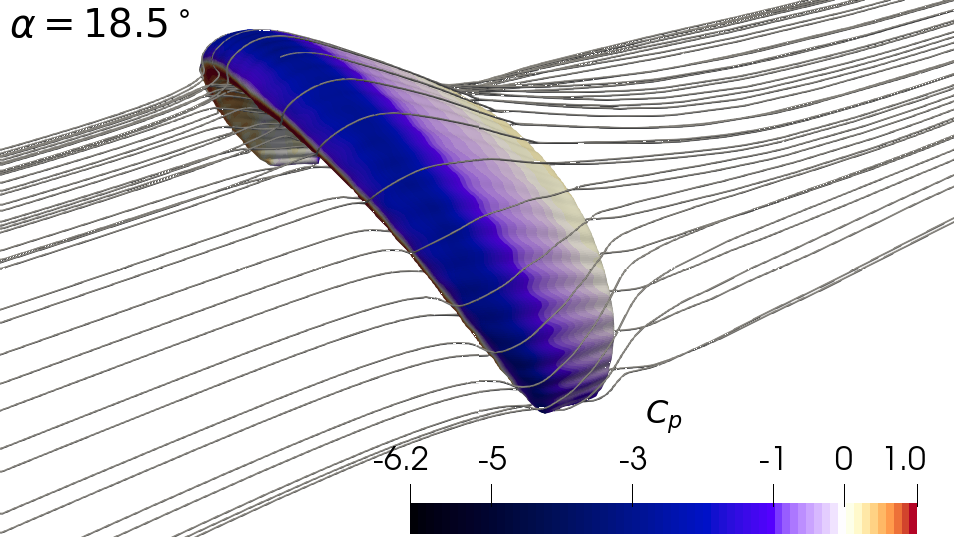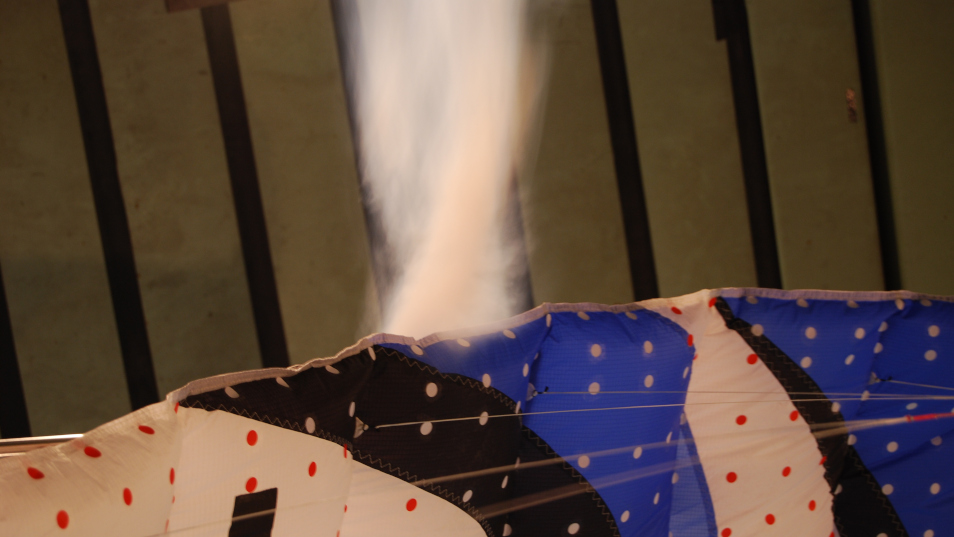Airborne Wind Energy
Design and aerodynamics of kites
Roland Schmehl
6 December 2024
Outline
- Kite design
- Soft kites
- Hybrid kites
- Kite aerodynamics
- Introduction
- 2D aerodynamics
- 3D aerodynamics
- Wind tunnel analysis
- In situ flow visualization
- In situ measurement of aerodynamics
Learning objectives
This lecture is about the design and working principles of kites, both soft wing as well as fixed wing kites. Some aspects of flight dynamics were already derived in previous lectures, and are here illustrated by experimental results (e.g. steering law, roll, pitch yaw, …)
Subtopics I
- Typology of kites for AWE
- Tube versus softkite, an epic battle?
- Aerodynamic loading as function of wing mass density (scaling)
- Working principles, steering and control of kites
- Differences rigid and soft kites
- Evolution of soft-wing kites and parafoils
- NPW-HA
- Trade-off between mass and wing loading
- Turn rate law for soft kites (Erhard and Strauch 2013; Vermillion et al. 2021)
- Experimental analysis of soft kite flight dynamics (Roullier 2020)
Subtopics II
- Update Bangor Erris: dataset, map and video of flight 2023-11-23
- Typology of kites for AWE (recap of lecture 1)
- Structural design concepts: design tree?
- How are soft-kites built (Roland V paper)
Kite design
Design requirements for AWE kites
- Fly-gen AWES
- High flight speed ⤳ high \(\CLmax\)
- Ground-gen AWES
- High pulling force during reel-out phase
- Low pulling force during reel-in phase
- Fast reel-in phase
Basic kite designs
Cherubini et al. (2015)
Boxwing flygen system
Kitekraft
Makani M600 vs Oktoberkite
Homsy (2020)
Makani M600 vs Oktoberkite
Homsy (2020)
Makani M600 vs Oktoberkite
Homsy (2020)
MegAWES kite
Eijkelhof and Schmehl (2022)
MegAWES kite
Eijkelhof and Schmehl (2022)
Scaling of kites for AWE applications
- Design of Solar Powered Airplanesfor Continuous Flight (Fig. 6) https://ethz.ch/content/dam/ethz/special-interest/mavt/robotics-n-intelligent-systems/asl-dam/documents/projects/Design_Skysailor.pdf
- The Simple Science of Flight - From Insects to Jumbo Jets (p. 14) http://home.kpn.nl/ronvans/forums/Simple_Science_of_Flight.pdf
Enerkite wing
Soft kites
Scaling tube kites
Static force equilibrium of finite membrane element
⤳ maintaining maximum tensile stress in membrane requires reducing tube pressure when scaling up
Soft kite aero-structural designs
TU Delft soft-kites (front views)
TU Delft soft-kites (side views)
Depowering
Heuvel (2010)
Relative flow
It can be shown that the angle of attack does not vary along the flight path of a massless kite if the angle between wing and tether is constant.
Vlugt et al. (2019)
Single skin kite
Courtesy of Bryan van Oostheim
Flying the single skin kite
Single skin kite
Courtesy of Bryan van Oostheim
Flying the single skin kite
Single skin kite
Courtesy of Bryan van Oostheim
Flying the single skin kite
Hybrid kites
Kitedynamics
Kite aerodynamics
Learning objectives
- Experimental characterization
- Computational methods (Lebesque 2020)
- Rigid kites (Vimalakanthan et al. 2018)
- Ram air kites (Wachter 2008)
- Soft kites (Oehler and Schmehl 2019; Schmidt et al. 2020)
Introduction
We first qualitatively illustrate the aerodynamics of rigid kites and softkites using experimental flow visualization and computational fluid dynamics. Material from the MSc thesis of Aart de Wachter. Two- and three-dimensional flow phenomena are distinguished. This is purely about the fluid dynamics of the wings.
2D aerodynamics
- Rigid kites
- Conventional airfoil
- High-lift airfoil
- Multi-element airfoil
- LEI tube kites
- Ram air kites
- Single-skin kites
Attached and separated flow

- Low angle of attack
- Laminar, attached flow
- Viscous effects in boundary layers and wake flow

- High angle of attack
- Fully separated flow on suction side
- Viscous effects also in separated flow
DLR
Boundary layer separation
LES of a pitching airfoil
http://doi.org/10.1115/1.4039235
Multi-element airfoil Makani Oktoberkite

Multi-element airfoil Ampyx AP3
Multi-element airfoil Ampyx AP3

Multi-element airfoil flow phenomena

http://doi.org/10.1016/S1270-9638(02)00002-0
Multi-element airfoil optimization

De Fezza and Barber (2022)
Leading-edge inflatable airfoil
Single skin airfoil




3D aerodynamics
- All three types of kites are jointly discussed as the three-dimensional flow is similar.
- Flow visualizations and interpretation by lifting line theory
Prandtl lifting line theory
- “[…] the loss in vortex strength is shed as a vortex sheet all along the trailing edge, rather than as a single trail at the wing-tips.”
- “Any change in lift distribution sheds a new trailing vortex, according to the lifting-line theory”
- https://www.slideshare.net/LeonineKunz/lecture-5-induced-drag

Computed flow field around the Ampyx AP3
Computed flow field around a ram-air kite
Trailing vorticity

Folkersma et al. (2020)

Wachter (2008)
Wind tunnel analysis
Photo credits: Max Dereta (2008)
Experimental challenges
- Scaling down large inflatable membrane wings
- Ram air wing:
- LEI wing: pressure in tube
- Suspension in the wind tunnel
Ram air wing
Finished wing setup
Photogrammetry markers
Camera setup
Pulse2 in wind canal
Wing tip vortex
Max Dereta (2008)
Kiteplane
Kiteplane
Kiteplane in wind canal
In situ flow visualization
Tell tales
Heuvel (2010), https://en.wikipedia.org/wiki/Telltale
Flow tufts
Kasper Masure, Vantage
In situ measurement of aerodynamics
CL and CD identification
Schelbergen2021
Learning Through Simulation & Real World Testing
After the in-flight break up of the Makani M600 in RPX-09 in April, 2018, the team did a comprehensive root cause analysis and dedicated even more effort to improving Makani’s suite of simulation tools so that we could crash in simulation before we crashed in the real world whenever possible.
Learning how the kite responded to different test cases in simulation also meant Makani could continue to accelerate learning even while we were not flying in the real world. Makani tried to prioritize learning as much as possible in simulation so that each real world flight test could teach us things we could not learn from simulation alone.
This video was shot between the crash of RPx-09 and Makani’s first All Modes Crosswind Flight off of the GS02 base station.
[Filmed by Kate Stirr and Andrea Dunlap. Edited by Andrea Dunlap.